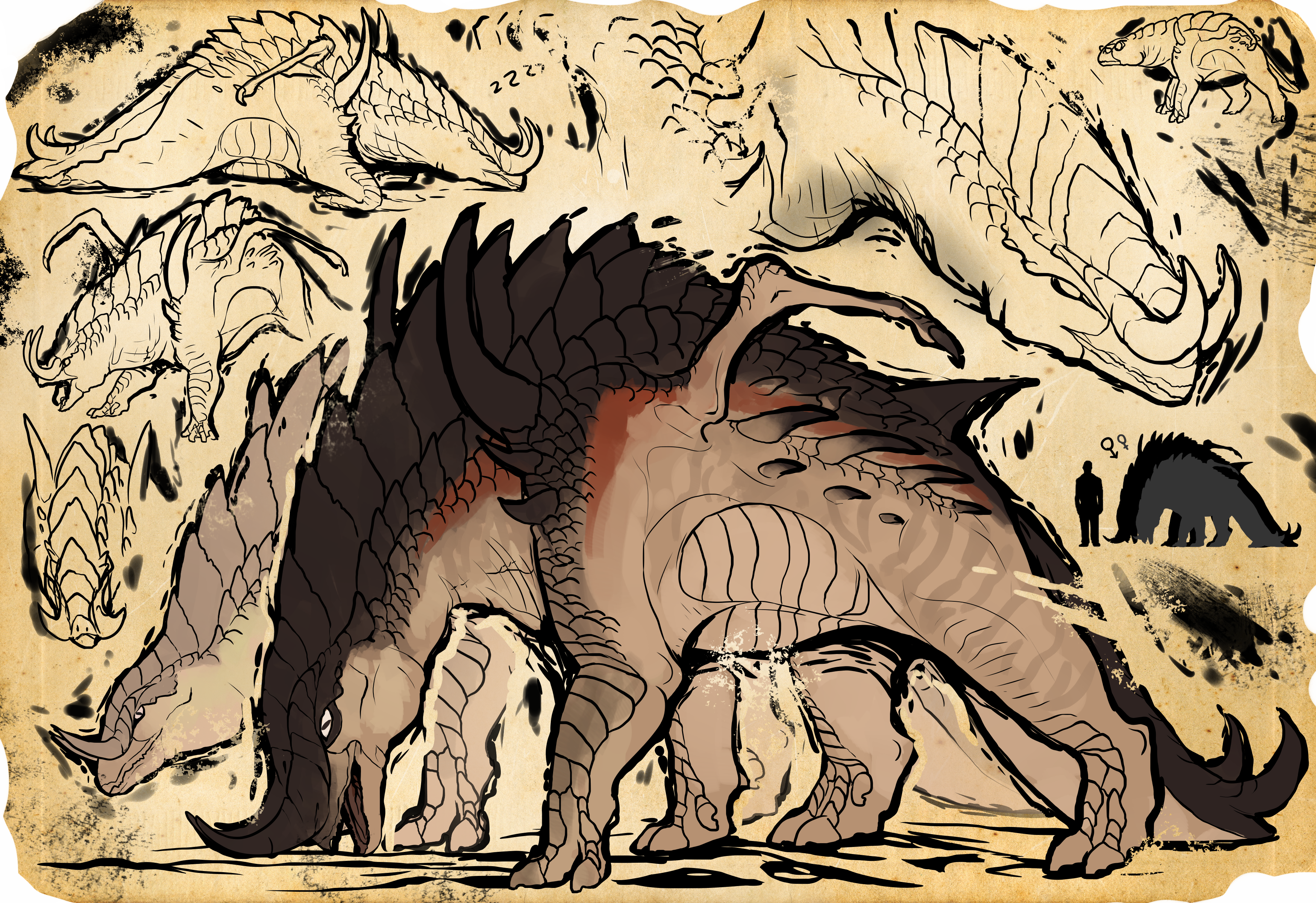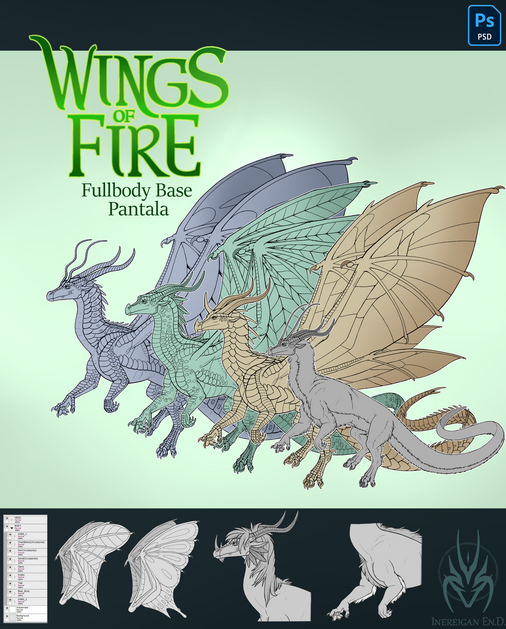HOME | DD
 Soulsplosion — [Scourge Files] Groduf
Soulsplosion — [Scourge Files] Groduf

Published: 2017-11-10 01:08:17 +0000 UTC; Views: 3990; Favourites: 284; Downloads: 11
Redirect to original
Description
Groduf
A desert-dwelling cousin of the Boar-Glider
Physique
Similar to Boar-Gliders, Grodufs are heavy-bodied creatures with high, muscular shoulders and low heads. They are rather front-heavy, displaying a distinctive hump of plated armor over their neck and shoulders. They have a pair of horns on the end of their snout (which is slightly smaller on females) that points along the ground, useful for both digging up plants and goring opponents. Their coloration is sandy with a darker topside, with males being much darker than females and having a notable red streak along their shoulders. Males are also slightly larger and more muscular. Behind their shoulders are what remains of their ancestors' wings; these flightless creatures' 'wings' are now small limbs with a single sharp claw, and are used to defend against predators attempting to pounce onto their back. At their shoulders are large spikes, and behind their vestigial wings are a prominent row of spikes. At their rumps are another pair of large spikes and at the bottom of their dragging tail are two large curved spikes that resemble the horns on their head, creating the appearance of a false head to deter attacks from behind.
Subspecies
Desert populations are of sandy colors while sparse forest populations tend to have darker, richer browns and reds. Other than this, they seem genetically identical and these different color morphs can intermingle seamlessly when they encounter each other.
Distribution
They are found solely within the Desert and Sparse Forest regions, but mostly in the desert.
Old skeletons have been found in other islands near the Sparse Forest, implying that they have at times managed to wander to other islands or have inhabited islands that drifted off of the Sparse Forest collectives and become terraformed by more lush plant-life, and they have never managed to thrive in these more densely-forested environments.
Lifestyle and Social Behavior
Herd sizes for most of the Desert's seasonal cycle range from 4-18 in size, but during the wet season they can reach up to 80 as herds coalesce for migrations and at nesting grounds. They spend most of their lives travelling in search of food and resources that are hard to come by in these dry areas; the migration routes of a herd are unique to the wants and needs of the members, and they will usually only travel familiar grounds, with veteran herds forming repetitive travel routes that they will return to each year.
Herds consist of a handful of highly-social females who will stay and graze together, followed by one or a few asocial males who will accompany the harem but graze alone. The cows alone decide the migration routes of the herd while the males follow, and these decisions are usually made peacefully, with females rarely having scuffles with each other unless they have offspring. Males on the other hand are highly aggressive to others of their gender and maintain a pecking order among themselves, often battling with each other over the rights to feed, mate, and even exist within proximity of the harem. The cows are often loyal to their particular group while bulls who fail to secure dominance will often switch between harems on a whim; unsuccessful (often subadult) males may wander alone or in small bachelor herds.
Feeding Behavior
They are capable of wandering miles without food or water. Extra calories are stored in the hallows of the armored plates along their back, and particularly malnourished individuals will display concave plates empty of nutrients. This caving can sometimes cause the plates to crack and become infected, and infection from this cracking is often the cause of death long before starvation.
They will graze on plants living on the surface and often dig ruts in the soil to forage for insects, fungi and roots growing beneath. They will often use their scoop-shaped horns to lift away stones and logs to forage for food living in the shade beneath. They have rather weak jaws compared to many creatures of Scourge and are unable to crack hard material such as Cluerke roots, and must resort to soft food or food that can be swallowed whole.
They can become aggressive over the ownership of a feeding ground, particularly between males or mothers trying to secure food for their offspring.
Aggressive Behavior
Bulls are significantly more aggressive than cows, having way more scuffles both with each other and with predators. The bulls that exist on the outskirts of a harem will protect the harem from predators, regardless of their loyalty to, experience with, or rank within the herd. When threatened by predators, the bulls will typically approach the threat while the cows will flee. In the lack of bulls however cows can be just as aggressive and dangerous, and they know when they themselves must turn and fight.
When facing predators, Grodufs will keep their horns facing the enemy at all times and diligently remain between the enemy and whoever they may be protecting (be it males protecting females or females protecting young). Bulls are much more likely to chase down and attempt to gore their enemy even when they're fleeing and encounters with bulls can often be fatal for an unlucky predator, while females will remain stationary and only attack when approached.
When facing off with each other, Grodufs will often warn their opponent with loud huffs, snorts, and brief tosses of the head. Should their opponent object and attempt to fight back, they will battle by facing each other and ramming their shoulders into each other, interlocking their shoulder spikes and attempting to shove the opponent back. These confrontations rarely leave wounds, but in rare cases the ones' spikes may be broken off, in which case they will often die from infection or be permanently at a disadvantage in future battles as the spikes do not grow back.
Family Life & Life Cycle
Offspring may be born at any time of the year, but most are born during Desert's Wet Season, when plants and water become much more plentiful. During this time herds from all over a Desert island will merge into a massive mega-herd that heads together to the nesting region of that particular island, usually wherever is the most cool and has the most water. Sparse Forest populations often forego this tradition due to having smaller islands and more plentiful food year-round, but may still migrate to a nesting area for the wet season.
Cows and successful males in a mega-herd will often keep track of their herd mates even through mixing and remain together for the duration of the wet season. Only the most successful males will breed, and the wet season is when the most battling occurs between them. Gestation seems to be impacted by the mothers' health; calves born during the wet season may be born within a few months, while those born during dryer times and to mothers with less nutrition may be postponed for many more months. They are remarkably developed at birth, and each calf--born singularly, with no siblings--will immediately begin following its mother. When they have young females will become aggressive towards males that approach, as males will attempt to chase out the young of other males. They will rarely actually attempt to injure the young but will try to force the female to abandon them, but all females of a harem will collaborate to scare him off. At other times however females with young will also be aggressive with each other as they attempt to secure the best feeding grounds for their young, often foregoing their own meals so that their offspring may eat.
Calves will remain tightly by their mothers' sides. Females will often stay within the same herd and pick up the same migration routes, but may be forced to split if the herd is too large in size, in which they will remain with their siblings and often form smaller herd of their own. New subadult bulls on the other hand will be eager to leave the herd; as young bulls by their mothers' sides become older they will begin becoming more aggressive, gradually adopting the asocial nature of their fathers and remaining at the edges of the herd rather than with their mothers. Eventually they will leave to attempt to find a new harem.
────────────────────────────────────────────────────────────────────────────
Tumblr | Youtube | Instagram | FurAffinity | Adopts Account | Sketch Account | Commissions
Related content
Comments: 13

This is gorgeous! The hint of rust color was a really nice touch
👍: 0 ⏩: 1

Your style is just amazing and al the creatures look like they could come to life. Amazing...
👍: 0 ⏩: 1

Do you come up with these designs? Because they are amazing
👍: 0 ⏩: 1





























